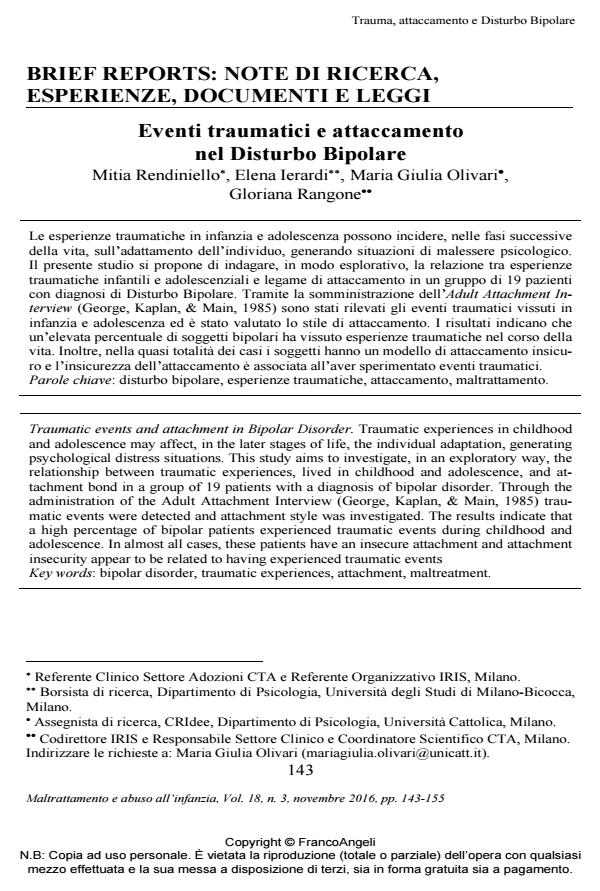Eventi traumatici e attaccamento nel Disturbo Bipolare
Titolo Rivista MALTRATTAMENTO E ABUSO ALL’INFANZIA
Autori/Curatori Mitia Rendiniello, Elena Ierardi, Maria Giulia Olivari, Gloriana Rangone
Anno di pubblicazione 2017 Fascicolo 2016/3
Lingua Italiano Numero pagine 13 P. 143-155 Dimensione file 184 KB
DOI 10.3280/MAL2016-003007
Il DOI è il codice a barre della proprietà intellettuale: per saperne di più
clicca qui
Qui sotto puoi vedere in anteprima la prima pagina di questo articolo.
Se questo articolo ti interessa, lo puoi acquistare (e scaricare in formato pdf) seguendo le facili indicazioni per acquistare il download credit. Acquista Download Credits per scaricare questo Articolo in formato PDF

FrancoAngeli è membro della Publishers International Linking Association, Inc (PILA)associazione indipendente e non profit per facilitare (attraverso i servizi tecnologici implementati da CrossRef.org) l’accesso degli studiosi ai contenuti digitali nelle pubblicazioni professionali e scientifiche
Le esperienze traumatiche in infanzia e adolescenza possono incidere, nelle fasi successive della vita, sull’adattamento dell’individuo, generando situazioni di malessere psicologico. Il presente studio si propone di indagare, in modo esplorativo, la relazione tra esperienze traumatiche infantili e adolescenziali e legame di attaccamento in un gruppo di 19 pazienti con diagnosi di Disturbo Bipolare. Tramite la somministrazione dell’Adult Attachment Interview (George, Kaplan, & Main, 1985) sono stati rilevati gli eventi traumatici vissuti in infanzia e adolescenza ed è stato valutato lo stile di attaccamento. I risultati indicano che un’elevata percentuale di soggetti bipolari ha vissuto esperienze traumatiche nel corso della vita. Inoltre, nella quasi totalità dei casi i soggetti hanno un modello di attaccamento insicuro e l’insicurezza dell’attaccamento è associata all’aver sperimentato eventi traumatici.
Parole chiave:Disturbo bipolare, esperienze traumatiche, attaccamento, maltrattamento
- Childhood trauma and social cognition in participants with bipolar disorder: The moderating role of attachment Javier Morán-Kneer, Ulises Ríos, Stefanella Costa-Cordella, Catalina Barría, Valeria Carvajal, Karyn Valenzuela, Dalia Wasserman, in Journal of Affective Disorders Reports 100359/2022 pp.100359
DOI: 10.1016/j.jadr.2022.100359
Mitia Rendiniello, Elena Ierardi, Maria Giulia Olivari, Gloriana Rangone, Eventi traumatici e attaccamento nel Disturbo Bipolare in "MALTRATTAMENTO E ABUSO ALL’INFANZIA" 3/2016, pp 143-155, DOI: 10.3280/MAL2016-003007